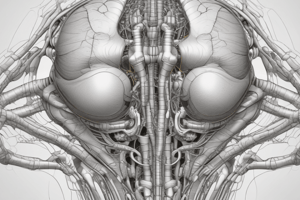Podcast
Questions and Answers
Muscles act as the motors that drive movement in humans and other animals. Which statement best explains the unique arrangement of myosin molecules?
Muscles act as the motors that drive movement in humans and other animals. Which statement best explains the unique arrangement of myosin molecules?
- Tails and heads alternating
- Tails and heads distributed randomly
- Tails together and heads in the middle
- Tails together and heads at the ends (correct)
Shortening and lengthening of sarcomeres affect the force generated by muscles during contraction.
Shortening and lengthening of sarcomeres affect the force generated by muscles during contraction.
True (A)
What is the main purpose of human functional anatomy?
What is the main purpose of human functional anatomy?
To better understand factors that influence both injury risk and human physical performance
In muscles, the parallel elastic component (PEC) includes membranes surrounding fibers, fascicles, and the whole muscle, contributing to preventing muscle from overstretching. Another component that decreases as fibers shorten during contraction is the _______.
In muscles, the parallel elastic component (PEC) includes membranes surrounding fibers, fascicles, and the whole muscle, contributing to preventing muscle from overstretching. Another component that decreases as fibers shorten during contraction is the _______.
In movements that require work to be performed, work (W) is calculated by multiplying ______ by distance (d).
In movements that require work to be performed, work (W) is calculated by multiplying ______ by distance (d).
What type of muscle fibers/fascicles allow for a larger range of motion?
What type of muscle fibers/fascicles allow for a larger range of motion?
What type of muscles have a lower metabolic cost due to less ATP use?
What type of muscles have a lower metabolic cost due to less ATP use?
Longer fibers in muscles can generate good force at higher shortening speeds.
Longer fibers in muscles can generate good force at higher shortening speeds.
Match the following muscle type with their property:
Match the following muscle type with their property:
What is the fundamental component of tendons?
What is the fundamental component of tendons?
Flashcards are hidden until you start studying
Study Notes
Introduction to Functional Anatomy
- Functional anatomy is an area of science that examines the functional role of musculoskeletal and neurological structures in human movement.
- It aims to better understand the factors that influence injury risk and human physical performance.
Muscle Structure
- Muscles are the motors that drive human movement.
- Myosin has a heavy chain (head, neck, and tail) and light chains that influence function.
- The head/neck (motor) domain bends to pull on actin, causing muscle contraction.
- Myosin molecules arrange themselves in a unique way, with tails together and heads at the ends, to cause muscle contraction.
Muscle Properties
- Muscle contraction is based on the cross-bridge model, where myosin heads rotate, detach, recover, and reattach to actin.
- The faster the cycle rate, the less time myosins are in contact with actin, resulting in less force produced.
- There is a force-velocity relation, where maximum force decreases as muscle shortening speed increases.
- Muscle force also changes with length, with fewer bound cross-bridges and actin-myosin collision at shorter lengths.
- Within a muscle, sarcomeres can be at different lengths, affecting muscle force.
Muscle Architecture
- Muscles have different designs, such as strap, unipennate, multipennate, and pennate, which affect muscle function.
- Pennate muscles have a greater physiological cross-sectional area (PCSA) for a given anatomical cross-section (ACSA).
- Fibres also rotate as they shorten, allowing for more force production in dynamic contractions.
Tendon
- Tendons transfer muscle forces to bones and have a hierarchical structure, with collagen as the fundamental component.
- Tendons are elastic due to covalent bonds between amino acids and exhibit load sharing and shear between fibrils and fascicles.
- Tendons can dissipate energy through shear during relaxation, which helps prevent injury and aids in braking.
Tendon Force-Length Relation
- Tendons stretch when loaded, with varying properties, and exhibit a force-length relation.
- The force-length relation can be normalised by stress and strain, allowing for comparison between tendons.
Tendon Stress-Strain Relation
- The stress-strain relation shows the relationship between stress and strain in tendons.
- Tendons can dissipate energy through hysteresis, which is good for injury prevention and braking.
Viscoelasticity
- Biological tissues, including tendons, are viscoelastic, exhibiting both viscous and elastic behaviors.
- Viscoelasticity is caused by fibril sliding and provides protection from injury and over-elongation.
Importance of Tendon and Muscle Function
- Understanding tendon and muscle function is crucial for understanding functional movement and preventing injury.
- Tendon and muscle function are influenced by various factors, including stiffness, hysteresis, and viscoelasticity.
Studying That Suits You
Use AI to generate personalized quizzes and flashcards to suit your learning preferences.



